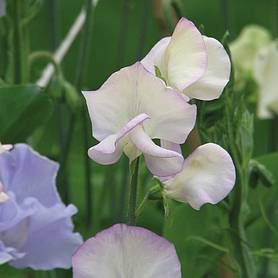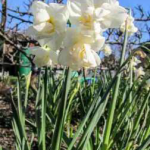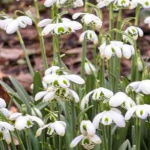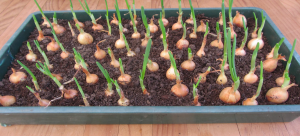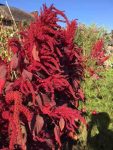
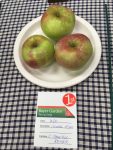
Maintaining soil and structures and planning ahead
- Continue to clear the ground of this summer’s growth, weeding as you go.
- Turn the compost heap to speed its decomposition.
- Compost fallen leaves in hessian bags. Compost pea and bean foliage,but leave the roots in the ground as they contain nitrogen.
- Plan where you will grow brassicas next year. Manure the area now and lime in the spring if the ph level is below 7.
- To maximise light levels and reduce harbouring of bugs, clean the green house with eco-friendly detergent. Garden disinfectant such as Jeyes Fluid can be used in a greenhouse or a sulphur candle if resident bugs are suspected.
- Make a last cut on grass paths and reinstate beds where grass has encroached.
- Apply grease bands around the trunks of fruit trees as a barrier to winter moths.
- Order bare-rooted fruit trees to be delivered November onwards. (See guidance on website and contact Site Secretary)
- Check that the bird netting on brassicas is secure in preparation for more wintry weather.
- Collect seeds of plants that have not been harvested. Peas and beans save well. Collect directly from the plant on a dry day to avoid fungal rot and put straight into paper bags.
Sowing and planting
- Winter salads and oriental greens can be sown in the green house or cold frame.
- Sow over-wintering broad beans either directly or start under cover in pots or root-trainers.
- Sow green manures such as rye, vetches or ryegrass to be dug in next February.
- Plant overwintering onion sets and garlic. Soil must be well drained. Onion sets should just peep above the surface. If the ph is lower than 7 add a little calicified seaweed. Plant garlic planted 1.5- 2”deep, spaced 7” apart. Both benefit from onion fertilizer.
- Plant daffodils, alliums and other spring bulbs for early spring flowering. (Hold off planting tulips till November.)
- Sow sweet peas in a cold frame or unheated greenhouse for early summer flowering and showing. Sow in root trainers or 3” pots.
- Plant out spring cabbage 6” apart.
- Take hardwood cuttings, 1ft long, from gooseberries and currants. Plant in pots of compost.
Harvesting
- Harvest winter squashes. Cut the squash carefully leaving a 2-3” stem. ‘Cure’ in a warm, dry place for 10-14 days, then in a cool, light place at around 50-55F until ready to eat. Many squash can be stored for up to 6 months.
- Store disease-free apples, pears and potatoes in a cool, dry place.
- Ensure carrots are protected with insect mesh as carrot flies are most damaging in late summer and autumn. Leave in the ground to harvest as needed.
- Harvest maincrop potatoes. Check each tuber for disease or damage and do not store damaged tubers. Store in a cool, dry place. Let the tubers dry off before storing in jute, hessian or paper bags in a dark frost-free place.
Pruning
- Lift and divide rhubarb plants that have been in situ for more than 5 years or are less productive. Keep and replant the newer outside growth and discard the centre.
- Cut down asparagus stems as they turn yellow and mulch with well-rotted manure.
- Clear away strawberry foliage to prevent build-up of pests and diseases.
Gardening for wildlife
- Leave decorative perennial seed heads as food and habitats for wildlife
- Build an insect hotel or install a log pile.
